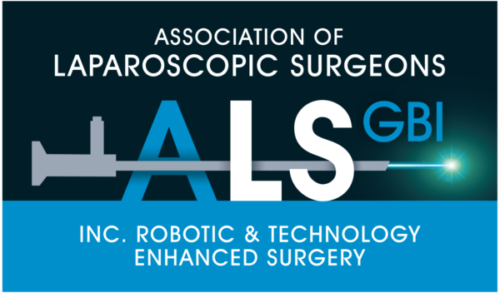Laparoscopy in the Covid-19 environment: ALSGBI Position Statement (Conventional and Robotic)

Trusts are now increasing elective surgical work and are continuing to do so despite the recent increase in new cases. Patients are stratified into low and high (and even intermediate) Covid-19 risk groups. How surgeons approach these patients and the protection measures they take is a choice each trust and surgeon will need to consider. The ALSGBI strongly considers that laparoscopic surgery should still be employed in treating both elective and emergency patients and encourages surgeons to be familiar with our most recent statement.
Covid-19 is a highly contagious RNA virus with a size range of 0.06 to 0.14 microns. Along with the nasopharynx and upper respiratory tract, the virus can be found in the entire GI tract. The virus has been found in nasal swabs, saliva, sputum, throat swab, blood and faeces. The only known modality of spread is through respiratory droplet transmission. Despite the concern regarding aerosolisation, there is currently no evidence of viral transmission during laparoscopy.
ALSGBI support the Intercollegiate statement, which was based on recommendations for surgery in the emergency setting, where patient Covid-19 status cannot be readily assessed. Trusts are already making longer term plans for the safe implementation of elective surgery. The Intercollegiate Guide To Surgical Prioritisation has rightfully recommended appropriate stratification of surgical waiting lists (1).
The decision-making process should take in to account the safety and well-being of the patient, the safety of the staff and the local resource implications. There is no evidence to suggest an increased risk of laparoscopy compared to open surgery in the elective setting. The views of the ALSGBI are that laparoscopy carries significant benefits to the patient and hospital and these should be part of each individual decision-making process.
Laparoscopy (including robotic techniques) carries the advantage of a decreased length of stay & consequent increased hospital bed availability. For the patient, laparoscopy may result in a decreased risk of complications and a faster recovery. Laparoscopy allows a self-contained operative field with less risk of fluid spillage. Operative staff are in much closer proximity during open surgery and therefore there is potential increased risk of cross-contamination, compared to laparoscopic or robotic surgery. ALSGBI would therefore support the use of laparoscopy in cases where there are clear benefits to the patient and where the hospital and theatre resources allow this to be a safe option for the patient and theatre staff.
There are specific procedures prioritised as Type 2 or 3 within the Guide to surgical priorities that ALSGBI feel would benefit from a laparoscopic approach.
There is a developing international consensus that elective surgery should continue and the perceived risks of aerosol production in laparoscopy can be minimised with appropriate techniques (2, 3, 4). ALSGBI therefore make the following recommendations for elective surgery while Covid-19 infection remains a risk:
1. Routine use of Covid-19 testing and pre-operative self-isolation for all suitable patients, following national guidelines.
2. Routine use of appropriate PPE for all operating theatre staff, following national guidelines.
3. Elective laparoscopic procedures should be performed in a designated ‘clean’ area, with suitably trained theatre staff.
4. Laparoscopic procedures should be carried out by senior, trained laparoscopic surgeons, in order to minimise operating time and potential of aerosolisation. Prolonged procedures may entail dual consultant operating & the need for regular breaks to reduce fatigue. Surgical training can be introduced where clinically appropriate and where the trainee is aware of the precautions required to reduce aerosolisation.
5. Routine use of a closed circuit smoke evacuation / ultra-low particulate air (ULPA) filtration system. Ultra-Low Particulate Air (ULPA) filters can remove 99.99% of airborne particles with a minimum particle penetration size of 0.05 microns (Aerosol particle size <5microns).
6. Use of techniques to minimise possible aerosolisation from port sites:
– Careful insertion techniques, to reduce bleeding & gas leak.
– Use of the smallest possible incision for the selected port.
– Minimising instrument exchanges, to reduce gas leak or port valve damage.
The operating surgeon should decide what they consider to be the safest port use to reduce air leak/aerosolisation. Whether that means ports that have features that may reduce leak or not needs to be considered.
7. Use of the lowest abdominal insufflation pressure for safe progress (12mmHg or less).
8. Minimal use of energy devices during procedures, to reduce smoke plume & particle aerosolisation.
10. Routine closed evacuation of all gas at the end of procedure, prior to specimen & port removal. Extra care should be taken to prevent port site bleeding where direct visualisation of ports during removal is not possible.
Continuation of elective surgery should include careful case selection, starting with a younger patient group (under 70 years), with fewer comorbidities (ASA <2), aiming for day case / reduced hospital stay as standard practice. Subspecialty guidance should be included in this decision-making process (5). Elective surgery should be deferred where Covid-19 infection is either identified or suspected. The risks and consequences of Covid-19 infection should form part of the informed consent process. We also recommend that data continues to be submitted to available prospective databases to increase knowledge in this area.
ALSGBI are keen to work with the Royal Colleges and fellow Specialty Associations to ensure ongoing safe practice for staff, within available resources. We recommend that best practice for patients is not compromised in this process.
References:
1. https://www.england.nhs.uk/coronavirus/wp-content/uploads/sites/52/2020/03/C0221-specialty-guide-surgical-prioritisation-v1.pdf
2. https://www.sages.org/recommendations-surgical-response-covid-19/
3. https://bjssjournals.onlinelibrary.wiley.com/doi/epdf/10.1002/bjs.11646
4. Vigneswaran Y, et al. What Is the Appropriate Use of Laparoscopy over Open Procedures in the Current COVID-19 Climate? J Gastrointest Surg. 2020 Apr 13: 1–6. doi: 10.1007/s11605-020-04592-9 [Epub ahead of print]. PMID: 32285338. https://doi.org/10.1007/s11605-020-04592-9
5. https://www.bomss.org.uk/wp-content/uploads/2020/06/BOMSS-Restarting-Bariatric-Surgery-in-the-COVID-Era-Guidelines_May-2020.pdf








Thank you for sharing such great information.
It has help me in finding out more detail about de-risking your surgical practice for COVID-19
“Thank you for sharing such great information.
It has help me in finding out more detail about legal complications in COVID-19 times“
Thank you for sharing such great information.
It has help me in finding out more detail about learn basic to advance oxygen therapy and administration in pediatric patients